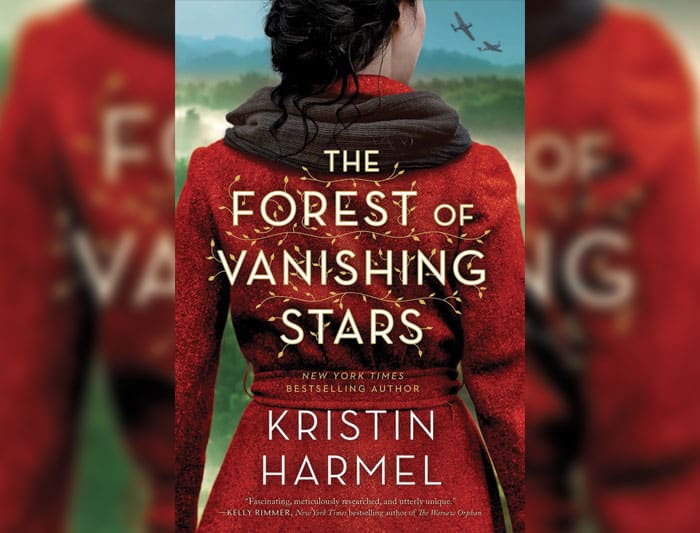
What do you get when you cross Henry Fielding’s “The History of Tom Jones, A Foundling” (a picaresque novel about an orphan, with a twist ending), Israel Zangwill’s iconic play “The Melting-Pot” (a love story between a Jew whose family was murdered in a pogrom and a Gentile whose father ordered the pogrom), and “Schindler’s List” (in which a German plays the role of savior for Jews destined for death at the hands of the Nazis)? Throw in a bit of fairy dust, and you have Kristin Harmel’s latest bestseller “The Forest of Vanishing Stars.”
Let me begin by saying that I really wanted to love this book. Too little has been written about, as history book writer Rebecca Frankel recently called them in The New York Times, “the forgotten Jews of the forest.” Harmel’s “vanishing stars” indeed represent a history that has nearly vanished, lacking the meticulous records that Nazis kept of the concentration and death camps.
Commemorating the stories of these forgotten Jews is very personal for me. Like the Jewish characters in Harmel’s novel, my grandparents resided in that area of Poland/Ukraine/Belarus that came under Soviet rule at the start of World War II — the first blow to the Jewish community — and then the Nazis as of June 1941. Like Harmel’s characters, my grandparents were forced into ghettoes. They escaped to the forest. The Nazis, meanwhile, rounded up their family members and shot them into mass graves. Of almost 20,000 Jews in Lutsk, where my grandmother lived, only 150 remained by the time the Soviets returned to liberate the forest Jews in 1944; my grandmother was among them. My grandparents stayed alive by hiding in empty barns and under the protective cover of the trees, begging or stealing food from farmers. They were not organized partisans, or vengeance-driven, gun-wielding fighters, like the Bielski brothers portrayed by Daniel Craig and Leiv Schreiber in the film “Defiance” (a source Harmel relies on heavily). More like the majority of Jews who fled to the forest from ghettoes, the Jews about which Harmel writes, they were simply trying to survive.
But if I came to this novel looking for a realistic historical account, I did so in error. Although well-researched, “The Forest of Vanishing Stars” is a book that, at heart, aims to entertain readers. Take Harmel’s heroine: Inge, a young German woman, is depicted as a character straight out of a fairy-tale. She has “hair, the color of the deepest starless night,” that “tumbled down her back”; lips “the startling red of corn poppies”; mismatched eyes, “one twilight blue and one forest green”; and skin “impossibly white.” On the inside of one wrist, she has a dove-shaped birthmark, “a sign [she] was special, that she was fated for something great.” As an infant, Inge is kidnapped by Jerusza, an ancient witch-like Jewish woman who becomes her stepmother and spends the rest of her days giving her young ward a vast education that includes a range of European languages, knowledge of religious texts, woodworking skills, and all the ways to kill an enemy. Even after Jerusza dies, the heroine feels her protector’s spirit guiding her, a bit like Obi-Wan Kenobi with Luke Skywalker.
Inge shares her stepmother’s magical powers; in fact, perhaps hers are stronger. She sees glimpses of the future, knows when danger is near. Jerusza’s lessons, along with her own supernatural extras, allow Inge, who is renamed Yona (the Hebrew word for dove), to be in the ideal position to save the influx of Jews whom she discovers are running into the woods. They come from Mir, from Volozhin, from Lida; from all around the edges of the Nalibocka Forest, Jews are seeking a safe haven, as it becomes readily apparent that to stay in the ghetto is to die.
Throughout “The Forest of Vanishing Stars,” Jews, and some non-Jews, come under Inge’s care. Not every one of Inge’s forest-dwellers accept the heroine’s help immediately. Some of the female Jews are jealous of Inge/Yona’s beauty; some of the men resent her leadership. But all of them are wise to listen to her, and most of them are thankful that she is there to save them. “We should all be kissing the ground you walk on,” one tells her. And another says, “Yona, you saved us. You are a true gift from God.”
They died when they contracted typhus. They died of starvation. They died of exposure. A little magic would have been nice.
The sad reality, and I think one of the reasons that I struggled with this book, is that the historical Jews didn’t have a savior that looked like Snow White and possessed supernatural powers to teach them how to survive in the forest or warn them when danger was coming; they had to figure it all out on their own. And whether or not they learned which berries were safe to eat or how to build a shelter underground, many, many died. (To be fair, a good number die in the book, too.) They died because they were caught by the Nazis. They died because they were caught by Nazi collaborators. They died when they contracted typhus. They died of starvation. They died of exposure. A little magic would have been nice.
That said, I can certainly see how Harmel’s novel has widespread appeal. It’s sad but uplifting. It has a beautiful, good-hearted heroine, and anyone reading the novel — Jewish, not Jewish, whatever — can imagine that if they were in her shoes, they too would act virtuously and save all the people they could save. The novel has romance, high drama and a lot of action. It’s fast-paced. It has magic. It does what fiction can do: tell a better than story than the real one.
It’s not true that “The Forest of Vanishing Stars” is just there to entertain. It absolutely educates as well. In fact, it’s a mark of good historical fiction when a novel can do both.
And it’s not true that “The Forest of Vanishing Stars” is just there to entertain. It absolutely educates as well. In fact, it’s a mark of good historical fiction when a novel can do both. So, while this novel is not quite my taste, I can’t help but tip my hat to the author for putting the spotlight on “the forgotten Jews of the forest” and telling a Holocaust story in a way that is fresh, different and exciting.
Karen E. H. Skinazi, Ph.D, is Associate Professor of Literature and Culture and the director of Liberal Arts at the University of Bristol (UK) and the author of Women of Valor: Orthodox Jewish Troll Fighters, Crime Writers, and Rock Stars in Contemporary Literature and Culture.























 More news and opinions than at a Shabbat dinner, right in your inbox.
More news and opinions than at a Shabbat dinner, right in your inbox.